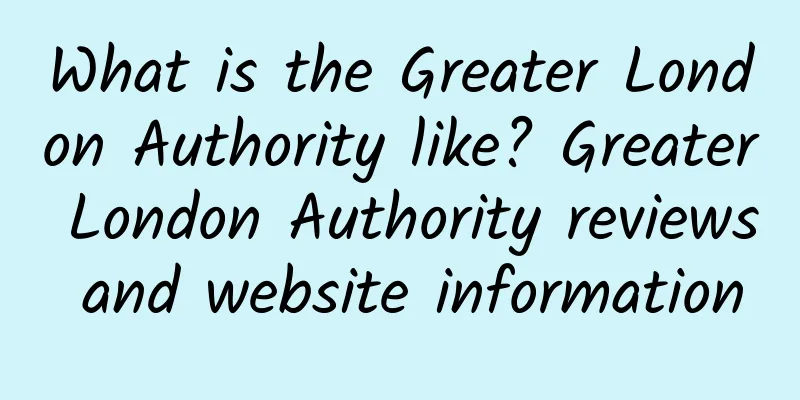What is the Greater London Authority like? Greater London Authority reviews and website information

|
What is the Greater London Authority website? The Greater London Authority (GLA) is a local government in the United Kingdom that governs the entire Greater London area. The government is led by the mayor and supervised by the London Assembly. Its office is located in City Hall on the south bank of the Thames near the Tower Bridge in London. Website: www.london.gov.uk The Greater London Authority (GLA) is a local government in the United Kingdom that is responsible for managing the affairs of the entire Greater London area. As the highest administrative body in the British capital of London, the Greater London Authority plays a vital role in the political, economic, social and cultural life of London. This article will introduce in detail the organizational structure, functions, historical background of the Greater London Authority and its impact on the lives of London citizens. 1. The organizational structure of the Greater London AuthorityThe Greater London Authority consists of two main parts: the Mayor of London and the London Assembly. The Mayor of London is the highest executive of the Greater London Authority and is responsible for formulating and implementing policies and strategies for London. The London Assembly is responsible for overseeing the work of the Mayor and ensuring the transparency and accountability of the government. 1. Mayor of LondonThe Mayor of London is the core figure of the Greater London Government and is directly elected by the citizens of London for a four-year term. The Mayor has extensive powers, including setting budgets, formulating transportation policies, planning urban development, managing police and fire services, etc. The current Mayor is Sadiq Khan, who was first elected in 2016 and successfully re-elected in 2021. 2. London ParliamentThe London Assembly is composed of 25 members, 14 of whom represent London's 14 constituencies and 11 of whom are elected through proportional representation. The Assembly's duties are to review the mayor's decisions and policies, make recommendations, and intervene when necessary. The Assembly is also responsible for overseeing the finances of the Greater London Authority and ensuring the rational use of public funds. II. Functions of the Greater London AuthorityThe main functions of the Greater London Authority are to provide high-quality public services to Londoners and promote sustainable development in London. The following is a detailed introduction to its main functions: 1. Traffic managementThe Greater London Authority is responsible for managing London's public transport system, including the subway, buses, light rail and taxis. The mayor works with Transport for London (TfL) to develop transport policies, improve transport infrastructure, reduce traffic congestion and improve the efficiency and safety of public transport. 2. Urban PlanningThe Greater London Authority is responsible for formulating and implementing London's urban planning policies to ensure the sustainable development of the city and the rational use of land resources. The Mayor works with the London Planning Commission (London Plan) to develop long-term urban development strategies, including the construction of housing, commercial, industrial and cultural facilities. 3. Environmental protectionThe Greater London Authority is committed to improving London's environmental quality and reducing air pollution, noise pollution and greenhouse gas emissions. The Mayor works with the London Environment Strategy to develop and implement a series of environmental policies, including promoting green energy, improving waste management and increasing green space. 4. Public safetyThe Greater London Authority is responsible for managing London's police and fire services to ensure the safety of citizens. The Mayor works with the Metropolitan Police Service and the London Fire Brigade to develop and implement public safety policies and prevent and respond to crime, fire and other emergencies. 5. Economic DevelopmentThe Greater London Authority promotes economic growth and employment opportunities in London by formulating and implementing economic development policies. The Mayor works with the London Development Agency to support the development of small and medium-sized enterprises, attract domestic and foreign investment, and enhance London's global competitiveness. 6. Social ServicesThe Greater London Authority provides a range of social services to Londoners, including education, health, housing and welfare. The Mayor works with London Social Services to develop and implement social policies to improve the quality of life of citizens and reduce poverty and inequality. III. Historical Background of the Greater London AuthorityThe history of the Greater London Authority can be traced back to 1965, when the British government established the Greater London Council (GLC) to manage the affairs of the entire Greater London area. However, in 1986, the then Conservative government decided to abolish the Greater London Council and disperse its functions to London's 32 boroughs and the City of London. After the Labour government came to power in 1997, it decided to re-establish a unified Greater London Authority. In 1998, the British Parliament passed the Greater London Authority Act, which established the legal framework of the new Greater London Authority. In 2000, Londoners elected the Mayor of Greater London and the London Assembly for the first time, marking the official establishment of the Greater London Authority. IV. The impact of the Greater London Authority on the lives of LondonersThe Greater London Authority has a profound impact on the lives of Londoners through its wide range of functions and policies. The following are some of its main areas of influence: 1. Improve public transportationThe Greater London Authority has improved the convenience of travel for Londoners by improving the public transport system. For example, the mayor and the Transport Authority have worked together to expand the subway and light rail networks, increase the number and frequency of buses, improve traffic signals and road facilities, and reduce traffic congestion and pollution. 2. Promote economic developmentThe Greater London Authority has promoted London's economic growth and employment opportunities by supporting the development of small and medium-sized enterprises and attracting domestic and foreign investment. For example, the mayor and the London Development Agency have worked together to provide entrepreneurial loans and training, support technological innovation and the development of cultural and creative industries, and enhance London's global competitiveness. 3. Improve environmental qualityThe Greater London Authority has improved the quality of London's environment by developing and implementing environmental policies. For example, the Mayor and the London Environment Strategy have worked together to promote green energy, improve waste management, increase green space, reduce air pollution and greenhouse gas emissions, and improve the health of citizens. 4. Improve public safetyThe Greater London Authority improves public safety in London through its management of the police and fire services. For example, the Mayor and the Metropolitan Police have worked together to increase the police force, improve police-community relations, prevent and respond to crime, and increase citizens' sense of security. 5. Improve social servicesThe Greater London Authority improves the quality of life of Londoners by providing social services such as education, health, housing and welfare. For example, the Mayor and the London Social Services Agency have worked together to increase educational resources and health services, provide more public housing, and reduce poverty and inequality. V. Future prospects for the Greater London AuthorityAs London continues to grow and change, the Greater London Authority faces new challenges and opportunities. Here are some key areas for its future development: 1. Addressing climate changeThe Greater London Authority will continue to be committed to tackling climate change, reducing greenhouse gas emissions, promoting green energy, improving waste management, increasing green space and improving London's sustainable development. 2. Promote scientific and technological innovationThe Greater London Authority will continue to support scientific and technological innovation, attract domestic and foreign investment, support the development of small and medium-sized enterprises, enhance London's global competitiveness and create more job opportunities. 3. Improve public servicesThe Greater London Authority will continue to improve public services such as education, health care, housing and welfare, improve the quality of life of citizens, reduce poverty and inequality, and promote harmonious social development. 4. Improve public safetyThe Greater London Authority will continue to improve public safety, increase police force, improve police-community relations, prevent and respond to crime, increase citizens' sense of security and ensure London's prosperity and stability. In short, as the highest administrative body in London, the capital of the United Kingdom, the Greater London Authority plays a vital role in the political, economic, social and cultural life of London. Through its extensive functions and policies, the Greater London Authority provides high-quality public services to Londoners, promotes London's sustainable development and improves the quality of life of citizens. In the future, the Greater London Authority will continue to respond to new challenges and opportunities to promote London's prosperity and progress. |
<<: How is Ansaldo Bareda? Ansaldo Bareda review and website information
>>: How is Chile Real Estate Network? Chile Real Estate Network Reviews and Website Information
Recommend
Benefits of Motherwort Juice
How much do you know about the effects of motherwo...
Will drinking milk at night make you fat? Is drinking milk at night good?
Will drinking milk at night make you fat? Everyon...
How to make delicious chili sauce Ingredients and steps for making chili sauce
Chili sauce is a favorite of many people. It can ...
Nutritional value of wild eel
Wild eels are a food with high nutritional value....
What vegetables are good for your eyes?
People all know that eyes are the windows to the ...
How to make delicious octopus? How to make delicious octopus and its efficacy
Octopus is a kind of marine fish. It has tender m...
What are the benefits of drinking lemon water with salt?
Lemonade is a healthy drink that many people like...
Nutritional value of snake beans
Have you ever eaten snake beans? It is also calle...
The efficacy and function of lemon juice
Lemon is a very common household fruit. Lemon jui...
How to make whole grain porridge? How to eat whole grain porridge most nutritiously
The most important eating time of the day is in t...
The efficacy and function of purslane
I believe that many people have never heard of th...
What is the Reserve Bank of Australia like? Reserve Bank of Australia reviews and website information
What is the Reserve Bank of Australia website? The...
What are the effects of soaking thorn bubble in wine? Steps of soaking thorn bubble in wine
The prickly pear is a particularly popular fruit ...
Nutritional value of wild blackbird meat
Have you ever eaten wild blackbird meat? Do you k...
Nutritional value and efficacy of shiitake mushrooms
Shiitake mushrooms are the second largest edible ...









